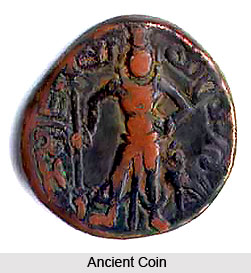 Yaudheya clan ahs also been mentioned in Ashtadhyayi of Panini as well as in Ganapatha. They have also been referred in Mahabharata, Mahamayuri, Brihatsamhita, Puranas, Chandravyakarana and Kashika. It is assumed that the chronology of Yaudheyas spans from as early as 500 BCE till 1200 CE. From about 200 BCE to 400 CE they were at the peak of their power.
Yaudheya clan ahs also been mentioned in Ashtadhyayi of Panini as well as in Ganapatha. They have also been referred in Mahabharata, Mahamayuri, Brihatsamhita, Puranas, Chandravyakarana and Kashika. It is assumed that the chronology of Yaudheyas spans from as early as 500 BCE till 1200 CE. From about 200 BCE to 400 CE they were at the peak of their power.
In Puranas Yaudheyas have been described as the descendants of Usinara and Nrigu.
They have been mentioned in Yaudheyas in Ashtadhyayi of Panini where Yaudheyas are mentioned amongst Ayudhajivin Sanghas. The Junagadh rock inscription of Rudradaman I acknowledged the military might of the Yaudheyas. The Allahabad pillar inscription of Samudragupta also mentioned about the Yaudheyas. In Brihat samhita, Varahamihira placed them in the northern division of India.
As per the coins the territory of Yaudheya included : in the west-Sutlej, Depalpur, Satgarha, Ajundhan, Kahror, Multan, in the east - Bhatner, Abohar, Sirsa, Hansi, Panipat and Sonipat and in the north - Kangra. The existence of this powerful clan has come to light from their coins and coin-moulds found in large number in this area. Most of these coins depicted the god Brahmanyadeva or Karttikeya. They were the rulers of South-Eastern Punjab and Rajasthan. They followed Hinduism.
This article is a stub. You can enrich by adding more information to it. Send your Write Up to content@indianetzone.com



















